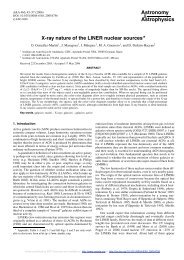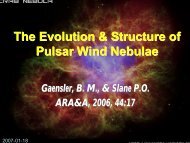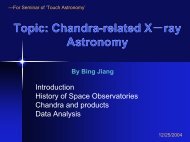Create successful ePaper yourself
Turn your PDF publications into a flip-book with our unique Google optimized e-Paper software.
(1) High overall luminosities<br />
Milky Way<br />
Radio galaxies<br />
Seyfert galaxies<br />
Quasars (3C 273)<br />
X-ray<br />
luminosity<br />
1<br />
100-5,000<br />
300-7×10 4<br />
2.5×10 6<br />
Optical<br />
luminosity<br />
1<br />
2<br />
2<br />
250<br />
Radio<br />
luminosity<br />
1<br />
2,000-2×10 6<br />
20-2×10 6<br />
6×10 6
Bright extragalactic radio sources
Normal galaxies<br />
Optical X-ray<br />
Quasar PKS 1127-145
(2) Non-thermal radiation<br />
Normal galaxies<br />
Blackbody radiation with peak<br />
energy at optical wavelength<br />
Radiation mainly comes from<br />
stars inside galaxies<br />
Active galaxies<br />
Non-stellar radiation<br />
Thermal (infrared) radiation +<br />
non-thermal radiation, with<br />
peak energy at far-infrared<br />
wavelength
(3) Unusual structure<br />
Bright nucleus, jets and irregular appearance
(5) Strong emission lines and polarized<br />
emission
Statistics of Active Galaxies<br />
Only 2% of all galaxies are active galaxies,<br />
bright active galaxies are more common at<br />
greater distances.<br />
Most active galaxies are ellipticals.<br />
The high luminosities of active galaxies<br />
implies a short lifetime, so active galaxies<br />
must represent a passing stage in the<br />
evolution of normal galaxies, rather than form<br />
a separate class of galaxies.
2. Radio Galaxies<br />
Active galaxies that emit most of their energy in the<br />
radio portion of the electromagnetic spectrum.<br />
Historical perspective<br />
In 1960s, British radio astronomers finished<br />
compiling the 3rd Cambridge (3C) catalog of radio<br />
sources.<br />
Many bright radio sources in the catalog were found<br />
to have optical counterparts (galaxies).<br />
They are both point-like and extended, and are<br />
called radio galaxies.
Cygnus A with two-lobe structure
(1) Characteristics<br />
Most active galaxies are radio galaxies.<br />
Radio luminosities ( ~10 42 -10 45 ergs -1 ) much<br />
higher than those of normal galaxies ( ~10 37 -<br />
10 39 ergs -1 ).<br />
Non-thermal synchrotron radiation.<br />
Most of them are elliptical galaxies, usually<br />
the brightest, largest ones in galaxy clusters.
Appearance<br />
Core-halo type: the radio<br />
images are comparable or<br />
slightly smaller than their<br />
optical images; most of the<br />
radio emission comes form<br />
the nucleus.<br />
Double-lobe type: extended<br />
structure (as long as 1 Mpc);<br />
the radio energy is released<br />
from the radio lobes.<br />
M86<br />
Centaurus A
M87<br />
The giant elliptical galaxy in Virgo cluster.<br />
The first galaxy found to have jets.<br />
The jet is about 2 kpc long and is made up of a series<br />
of distinct “blobs”.
NGC 1265: Head-Tail Radio galaxy
0313-192: The Wrong Spiral Galaxy
(2) Theoretical Model<br />
Energy is fired out from<br />
the nucleus in the form<br />
of narrow, high-speed<br />
jets that travel into the<br />
intergalactic medium<br />
and become extended<br />
lobes.<br />
Radio emission is<br />
produced by highspeed<br />
electrons in<br />
magnetic fields through<br />
synchrotron radiation.
Movement of radio galaxies causes different<br />
appearance.
The system may appear to us as either a lobe or a<br />
core–halo radio galaxy, depending on our location<br />
with respect to the jets and lobes.
Comparison: Seyfert Galaxies and Star Burst<br />
Galaxies<br />
Seyfert galaxy<br />
NGC 7742<br />
Starburst Galaxy M94
In type II, all allowed and forbidden lines are similar<br />
and narrower (≤10 3 kms -1 ) .<br />
Seyfert I<br />
Seyfert II
The reason for this difference is thought to be that the<br />
allowed lines are formed in denser gas near the<br />
nucleus (broad line region), and the forbidden lines in<br />
more diffuse gas further out (narrow line region).<br />
In type II Seyfert galaxies the denser gas is missing<br />
or obscured.
The activity of some Seyfert galaxies may result from<br />
galaxy interactions.<br />
Visible-light (left) and radio (right) image of galaxy pair:<br />
Radio image shows gas streaming between galaxies.
Non-thermal continuum with very weak or no<br />
emission lines.
Most energy emitted in γ-ray, with strong radio<br />
and infrared radiation.<br />
Usually elliptical galaxies.<br />
3C 279
Rapid and violent variability within days to<br />
months.
5. Quasars, QSOs<br />
Optically appear almost<br />
as point sources.<br />
Quasars – quasi-stellar<br />
radio sources<br />
QSOs – quasi-stellar<br />
objects.
The first quasar 3C273 with very strong,<br />
wide, unknown emission lines<br />
In 1963 Maarten Schmidt interpreted<br />
the optical emission lines of 3C273 as<br />
hydrogen Balmer lines redshifted by<br />
16%.<br />
Maarten Schmidt<br />
HST+VLA
High-z Quasars Discovered in Sloan Digital Sky Survey
The Most Distant X-Ray Jet from Quasar<br />
GB1508+5714
Quasar Absorption Lines<br />
In addition to their own strongly redshifted spectra, many<br />
quasars also show additional “forest” of absorption lines<br />
starting at the wavelength of the quasar’s own Lyman-alpha<br />
emission line and extending to shorter wavelengths.<br />
These lines are interpreted as Lyman-alpha absorption features<br />
produced by gas clouds in foreground structures (galaxies,<br />
clusters, and so on) along the line of sight.<br />
Lyman-Alpha Forest in the spectrum of quasar QSO 1422 + 2309
Observational Features of Gravitational Lensing<br />
The lensing tends to amplify the light of the quasar,<br />
making it easier to observe.<br />
There is a time delay, ranging from several days to<br />
several years, between different images.<br />
Microlensing — lensing by individual stars in the<br />
foreground galaxy — can cause large fluctuations in<br />
a quasar’s brightness.
! =<br />
4GM<br />
2<br />
bc<br />
! ( " $ # )<br />
=<br />
D D<br />
S LS<br />
% = $<br />
D<br />
LS # " ! DL"<br />
DS<br />
For = 0,<br />
! =<br />
E 2<br />
4GM DLS<br />
c D D<br />
(
Time Delay in Lensing Images of Quasar RX<br />
J0911.4+0511<br />
Differences in the variation<br />
in each separate image<br />
can be used to tell<br />
information about the<br />
gravity and the expansion<br />
of the universe.
Abell 1835 IR1916, The Farthest Known<br />
Galaxy with a Redshift of 10
Dark Matter in Distant Galaxy Groups Mapped<br />
for the First Time
Implications from X-ray binaries<br />
Black hole accretion jets
RX J1242-11
Evidence of the Dust Torus<br />
Hydroxyl (OH) line emissions trace the obscuring material within<br />
the circumnuclear environment of the galaxy Markarian 231.
Super Massive Black Holes in Galactic Nuclei
















